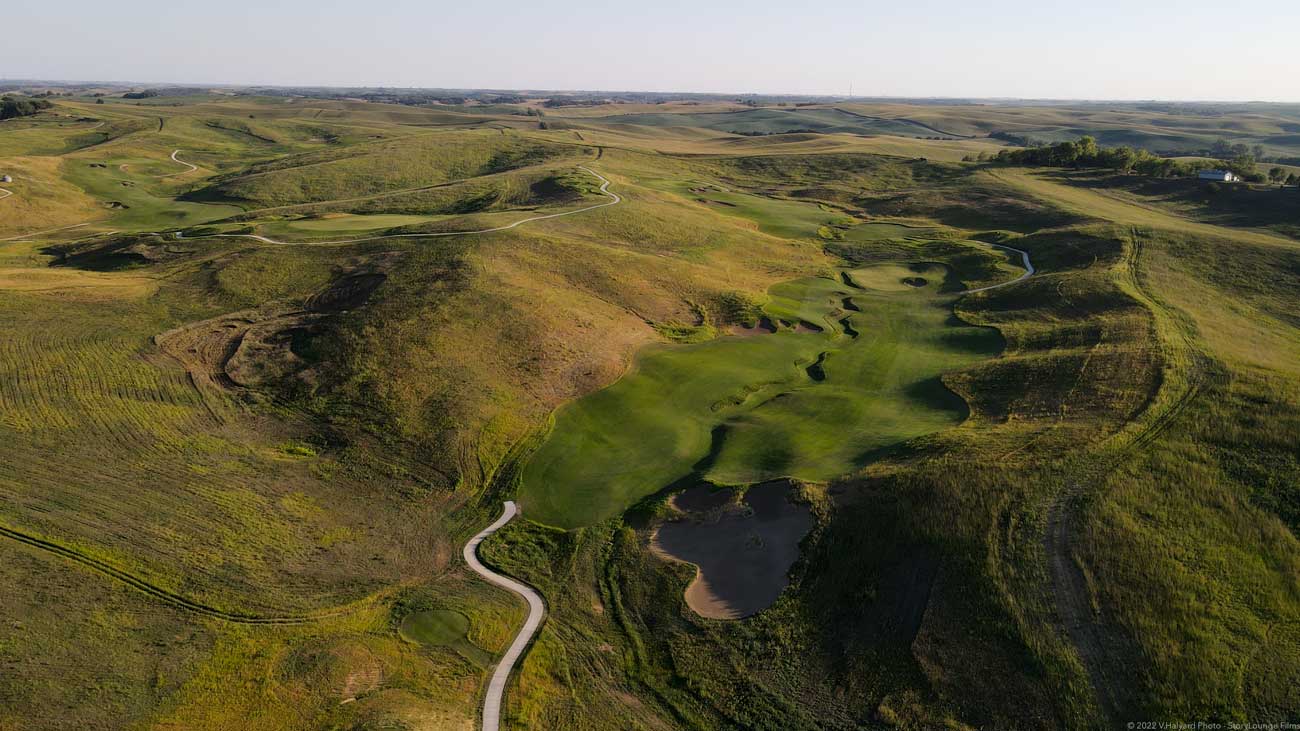Seven years after opening Sweetens Cove, their nine-hole triumphant underdog in Tennessee, design partners Rob Collins and Tad King have cut the ribbon on their first 18-hole project. Landmand Golf Club, in northeastern Nebraska, started welcoming public play last weekend. Given its pedigree, Landmand will inevitably draw comparisons to Sweetens — but it also deserves scrutiny on its own.
A handful of GOLF Magazine panelists were in the Cornhusker State last week for a sneak peek at one of the country’s most hotly anticipated courses, and we asked them for their early reviews of the design.

Let’s start with a game of compare and contrast. In what ways is Landmand similar to Sweetens Cove? In what ways is it different, aside from the fact that it has twice as many holes?
Steve Lapper, panelist since 2009; has played 84 of the Top 100: The easiest answer is scale. Both courses provide plenty of width off the tee. The difference is that while Landmand’s terrain is massive and dramatic, Sweetens Cove is intimate and restrained. Both courses allow for recovery creativity around the greens, yet Sweetens is far less severe and Landmand more expansive and steep.
Paul Rudovsky, panelist since 2015; has played all of the Top 100: Both are great fun, but they get to that point via totally different routes. Landmand is big and bold. Sweetens is cute and quirky, in the positive sense.
Adam Messix, panelist since 2015; has played all of the Top 100): Sweetens and Landmand both have bold and interesting greens and should appeal to shotmakers. They both fit their properties well and have their share of quirk. Sweetens is much more intimate than Landmand, which has a scale as grand as just about anything that I’ve seen.

Landmand has been described as “wild” and “bold,” an emblem of “architectural maximalism.” Those traits come with an air of adventure. They also carry an element of risk. In your opinion, how well does the wildness of the design work? Does it ever go too far?
Lapper: The adage “fortune favors the brave” comes to mind. This huge, rollicking site required bold thinking, and the King-Collins team obliged. There are a couple of spots on the course that are over the top or may have gone too far, yet these are relatively few, especially compared to the number of exciting and excellent holes that work well, even when pushing the conventional envelope. The influences of Mike Strantz’s iconoclastic Tobacco Road come to mind.
Rudovsky: The design works superbly. I saw it while it was still being shaped last summer and it occurred to me that just as there is a fine line between brilliant people and crazy people, there is also a fine line between spectacular golf courses and “over-the-top” courses. The King-Collins team stayed on the correct side of that line.

Thomas Brown, panelist since 2015; has played 95 of the Top 100: The property is 580 acres, which is huge. Few courses built in the modern era have given the golf architect such an open field to run with. The debate: Detractors may look at the green contours as excessive while admirers of the bold King-Collins style will enjoy finding ways to flight their approaches into sections of the green that yield flatter putts. The par-5 holes play uphill for the approach, which can get repetitive. Few eagle putt chances from the back tees will be seen without a helping breeze. Multiple rounds are required to learn all of the different hole locations.
Pete Phipps, panelist since 2021; has played 65 of the Top 100: As long as anyone who ventures to the far northeast corner of Nebraska knows what they are getting into, they’ll have fun playing a unique and memorable course. If you go in with an open mind and looking for a change of pace from conventional routings and terrain, you’ll appreciate the outside-the-box approach King Collins takes with their design (see: early Pete Dye, Mike Strantz). Every industry does better when certain concepts or personalities push certain envelopes, and if that’s the niche market King-Collins feels is their best fit, then more power to them. Again, as long as you read the brochure, you’ll have fun riding the rollercoaster!
Messix: The dramatic nature of the property and the constant presence of wind required a grand design. Most of the course ties in really well with the surrounding property, which is a credit to King and Collins. The property was not as easy to work with as it now appears. The course invites creative shotmaking with the amount of movement throughout and it will be the rare windy course that will appeal to both the strong playing shotmaker and the weaker player who usually bounces it around. Landmand requires some local knowledge as there are places to avoid as well as subtle ways to maneuver the ball close to the hole.

What’s your favorite hole, and why?
Lapper: The par-4 3rd. The incorporation of several rough-lined barrancas, diagonally and vertically splitting the fairway (similar to the bottle bunker formations found on the 8th at National Golf Links and the 5th at Baltusrol Lower) are aesthetically striking, visually intimidating and demand a strategic decision off the tee. The second (approach) shot is steeply uphill to one of the most interesting green complexes. It’s a terrific hole that would stand out on any course.
Rudovsky: The par-4 15th. It takes an oft-used concept (the Cape hole) and incorporates it into Landmand’s boldness and size. The result is superb.
Brown: I found the uphill 3rd, playing as a 475-yard par-4, to be a good challenge. The snaking terrace-line of rough Steve mentions divides the left fairway from the right fairway in a subtle manner. It adds just enough definition to a wide open uphill canyon tee shot. The manner of shaping the slope is an attractive feature which I cannot recall being used elsewhere.
Phipps: The par-3 14th deserves credit for actually pulling off a “true redan.” For a term that has turned into cliche podcast slang, King-Collins didn’t just make a redan for marketing purposes, they did it so you could watch your ball roll from one side of the massive green to the other for 20-plus seconds, building anticipation and excitement within your group.
Messix: When you first look at the tiny par-3 8th, you wonder whether it’s a part of the course. With a scorecard and pencil in your hand, it becomes a terror as the green is incredibly shallow. You step up on the tee with a bit of breeze in your face, it begs you to flight the ball. Downwind it requires a perfect strike to get the necessary spin to hold the green. Short holes that require precision are rare in modern design, and the 8th pulls that off impeccably.
Short holes that require precision are rare in modern design, and the 8th pulls that off impeccably.” Adam Messix
Any holes that need work?
Lapper: The par-5 15th has a semi-fatal flaw. The tee shot must clear an uphill slope at over 250 yards for you to get a view of what awaits: a fairway impinged on the right by native rough, with two large, pinching bunkers creating a narrow neck. This leaves two unappealing options: either a lay-up to 180-200 yards (too long for the average player), or a mammoth uphill strike covering 240-260 yards to a sizable green with a large false front. Either approach stifles any sensible risk-reward for most mere mortals. To my mind, this could be fixed easily by converting the native rough to fairway on the right.
Brown: I found the drivable 310-yard 17th hole limited in the always-go-for-it category, where I dream from. Perhaps I should move up from the back tees, because running the ball up onto the green isn’t especially realistic. You’ve got to fly it on. The bunkers are massive at Landmand, and the bunker in front of the 17th green is a magnet.
Phipps: The 13th hole has the best of intentions to follow in the footsteps of the super-cool 7th hole at Cal Club, but unfortunately — due to being pushed in a lesser corner of land — doesn’t entirely pull it off. It’s a sharp dogleg right with nothing blocking a big hitter from driving the green, but doesn’t play as well for the rest of us. For the average player, there isn’t any risk/reward element to the tee shot, leaving a longer than preferred uphill approach on a hole where your opponent might be putting for eagle. The difference with No. 7 at Cal Club is that even average hitters have the chance to catch a slope and have their drives get closer and closer to the green.
Messix: Every hole at Landmand fits in well in its setting and has plenty of strategic merit. I was disappointed with the 4th and 7th greens, where there were potential uber-cool hole locations that are unavailable because the green in those areas is too severe to be pinnable.
Green fees at Landmand are $150. You may reserve tee times here.
Need help unriddling the greens at your home course? Pick up a custom Green Book from 8AM Golf affiliate GolfLogix.










